Related Research Articles

Earl of Derby is a title in the Peerage of England. The title was first adopted by Robert de Ferrers, 1st Earl of Derby, under a creation of 1139. It continued with the Ferrers family until the 6th Earl forfeited his property toward the end of the reign of Henry III and died in 1279. Most of the Ferrers property and the Derby title were then held by the family of Henry III. The title merged in the Crown upon Henry IV's accession to the throne in 1399.

Tutbury is a village and civil parish in Staffordshire, England. It is 4 miles (6.4 km) north of Burton upon Trent and 20 miles (32 km) south of the Peak District. The village has a population of about 3,076 residents. It adjoins Hatton to the north on the Staffordshire–Derbyshire border.

Staffordshire is a landlocked county in the West Midlands of England. It adjoins Cheshire to the north west, Derbyshire and Leicestershire to the east, Warwickshire to the south east, West Midlands and Worcestershire to the south, and Shropshire to the west. The historic county of Staffordshire includes Wolverhampton, Walsall, and West Bromwich, these three being removed for administrative purposes in 1974 to the new West Midlands authority. The resulting administrative area of Staffordshire has a narrow southwards protrusion that runs west of West Midlands to the border of Worcestershire. The city of Stoke-on-Trent was removed from the admin area in the 1990s to form a unitary authority, but is still part of Staffordshire for ceremonial and traditional purposes.

William III de Ferrers, 5th Earl of Derby of Chartley Castle in Staffordshire, was an English nobleman and major landowner, unable through illness to take much part in national affairs. From his two marriages, he left numerous children who married into noble and royal families of England, France, Scotland and Wales.

Alien priories were religious establishments in England, such as monasteries and convents, which were under the control of another religious house outside England. Usually the mother-house was in France.

Tutbury Castle is a largely ruined medieval castle at Tutbury, Staffordshire, England, in the ownership of the Duchy of Lancaster and hence currently of King Charles III. It is a scheduled monument and a Grade I listed building. People who have stayed in the castle include Eleanor of Aquitaine and Mary, Queen of Scots, who was a prisoner there.
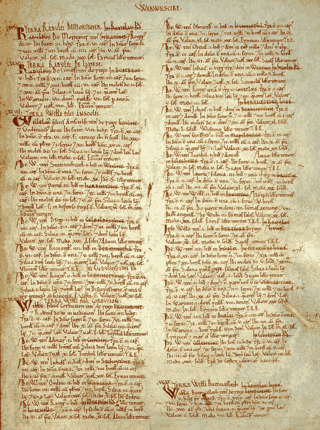
Henry de Ferrers, magnate and administrator, was a Norman who after the 1066 Norman conquest was awarded extensive lands in England.
William I de Ferrers, 3rd Earl of Derby was a 12th-century English earl who resided in Tutbury Castle in Staffordshire and was head of a family which controlled a large part of Derbyshire known as Duffield Frith. He was also a Knight Templar.

Chartley Castle lies in ruins to the north of the village of Stowe-by-Chartley in Staffordshire, between Stafford and Uttoxeter. Mary, Queen of Scots, was imprisoned on the estate in 1585. The remains of the castle and associated earthworks are a Scheduled Monument, the site having been protected since 1925. The castle itself is a Grade II* listed building

Lenton Priory was a Cluniac monastic house in Nottinghamshire, founded by William Peverel circa 1102-8. The priory was granted a large endowment of property in Nottinghamshire and Derbyshire by its founder, which became the cause of violent disagreement following its seizure by the crown and its reassignment to Lichfield Cathedral. The priory was home mostly to French monks until the late 14th century when the priory was freed from the control of its foreign mother-house. From the 13th-century the priory struggled financially and was noted for "its poverty and indebtedness". The priory was dissolved as part of King Henry VIII's Dissolution of the Monasteries.
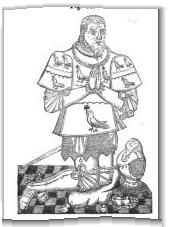
Sir John Port was an English landowner and Knight of the Order of the Bath who served occasionally in the House of Commons. He was High Sheriff of Derbyshire in 1554. By his will, he founded Repton School and almshouses at Etwall. He also owned Caverswall Castle from 1531 after acquiring it through marriage to Elizabeth.
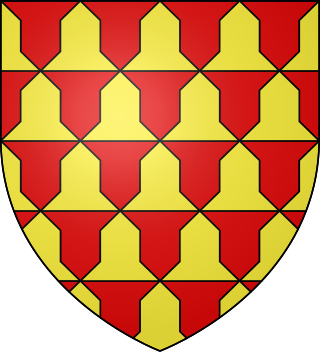
Robert de Ferrers, 6th Earl of Derby (1239–1279) was an English nobleman.

Norbury is a village in Derbyshire, England. It is located 3 miles (4.8 km) north of Rocester, on the B5033 road and the River Dove. The hamlet has links with George Eliot's family, the Evans. George Eliot's father, Robert Evans, was born in Roston Common and sang in the choir at Norbury church, and most of George Eliot's paternal ancestors are buried there.
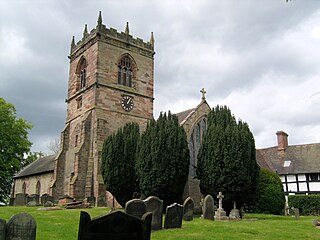
Lapley Priory was a priory in Staffordshire, England. Founded at the very end of the Anglo-Saxon period, it was an alien priory, a satellite house of the Benedictine Abbey of Saint-Remi or Saint-Rémy at Reims in Northern France. After great fluctuations in fortune, resulting from changing relations between the rulers of England and France, it was finally dissolved in 1415 and its assets transferred to the collegiate church at Tong, Shropshire.
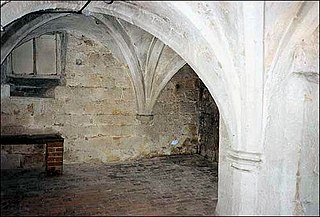
Stone Priory was a priory founded at Stone in Staffordshire, England, in about 670 AD. The priory's church was dedicated to Saint Mary and Saint Wulfad, a local seventh-century martyr and supposedly a son of King Wulfhere of Mercia, who ruled from 658 until his death in 675. The mid-15th century Rimed Chronicle of Stone Priory, found at the Priory at the Dissolution of the Monasteries, records the founding legend and the names of the Stafford family patrons up to 1403, and the places of their burials.
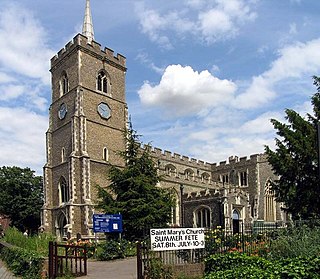
St Mary's Church is a grade I listed parish church in Ware, Hertfordshire, England.

The Tutbury bull run was a blood sport that took place in Tutbury, Staffordshire, from the 14th century until 1778. It formed part of the annual Court of Minstrels, a ceremonial legal proceeding for travelling musicians in the nearby counties. The Tutbury bull run is first recorded in 1414 but may be of earlier origin, though a story that it was begun by John of Gaunt to remind his Spanish wife of home is believed false. The bull was provided to the minstrels by Tutbury Priory and, after the Dissolution of the Monasteries, by the Duke of Devonshire. The bull would be chased through the town by the minstrels who could claim it if it was caught. It was afterwards baited to death and served in a feast. The event developed into a competition between Staffordshire and Derbyshire residents who competed to catch the bull within their own counties. After the decline of the Court of Minstrels the bull run developed into a drunken revel. It was abolished in 1778 after a man was killed during a mass brawl.
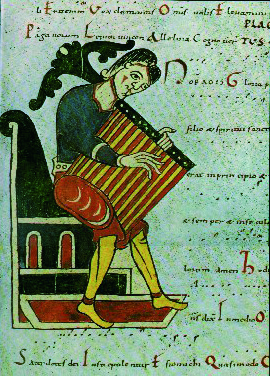
The Court of Minstrels was a court held in Tutbury, Staffordshire, for minstrels from the nearby counties. The court was founded by John of Gaunt, the Duke of Lancaster, who held Tutbury Castle, for the encouragement of the minstrels' art and for their better regulation. A King of the Minstrels governed the court and juries of minstrels adjudicated in disputes and complaints. The court met annually at Tutbury on the Assumption of Mary, 15 August, and the following day held entertainments including the Tutbury bull run. The court was ordered to cease in 1778 but seems to have continued into the early 19th century.

The Ferrers family were a noble Anglo-Norman family that crossed to England with the Norman Conquest and gave rise to a line that would hold the Earldom of Derby for six generations before losing it in rebellion. They also gave rise to several lines that held English peerages, the longest-living going extinct in the male line in the 15th century, as well as a Norman branch of the family that persisted into the 13th century. A French line persisted into the 16th century.
References
- ↑ B. Charles, "Priory church, Tutbury", in Journal of the British Archaeological Association, 1st ser (VII), 1852, pp. 390–96
- 1 2 Victoria County History of Staffordshire: Alien houses - Priory of Tutbury
- ↑ Corpus of Romanesque Sculpture in Britain and Ireland: St Mary, Tuutbury, Staffordshire
- ↑ CWGC Cemetery report: details from casualty record
